Your bedroom is more than just a place to sleep—it’s your sanctuary, retreat, and personal haven. It’s where you begin and end each day, and deserving of thoughtful design that nurtures both rest and self-expression. In fact, according to a 2023 sleep study by the National Sleep Foundation, the average person spends about one-third of their life in their bedroom, totaling nearly 26 years over a lifetime. With so much time spent in this space, shouldn’t it reflect who you are while supporting your wellbeing?
Whether you’re looking for a complete bedroom makeover or just seeking to refresh your current space, we’ve curated 22 inspiring bedroom interior ideas that go beyond basic decorating tips. Each concept is designed to not only enhance the aesthetic appeal of your bedroom but also improve its functionality and the quality of time you spend there.
1. Psychology of Color: Selecting Mood-Enhancing Palettes
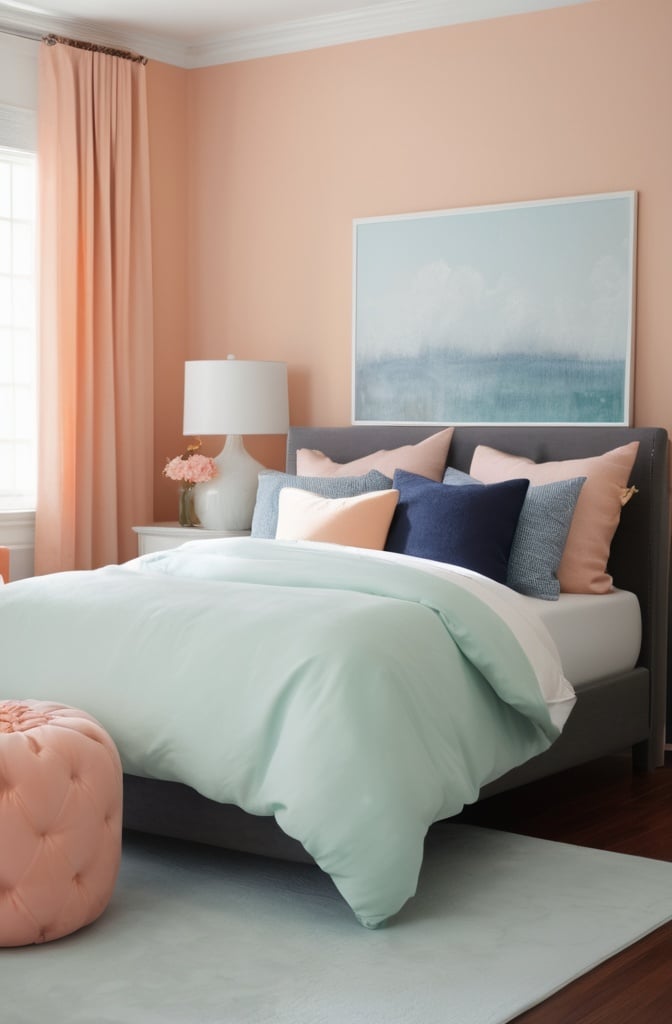
The colors you choose for your bedroom can profoundly impact your mood, sleep quality, and overall wellbeing. Unlike what many think, color pyschology isn’t just decorative—it’s functional.
According to color psychologist Dr. Angela Wright, “Blue is essentially soothing; it’s the color of calm and serenity.” Research from the University of Minnesota suggests that blue environments can actually lower blood pressure and heart rate, making it an excellent choice for restful sleep.
But don’t feel limited to traditional sleepy blues and greens. 2024’s trending bedroom palettes include:
- Terracotta and sage green combinations
- Lavender with warm neutrals
- Muted navy with coral accents
- Charcoal with dusty pink highlights
Pro tip: Before committing to a color, purchase sample pots and paint large swatches (at least 2ft square) on different walls. Observe how the color changes throughout the day as natural light shifts—you might be suprised how a color transforms from morning to evening.
2. Strategic Natural Light Management

Natural light doesn’t just illuminate your space—it regulates your circadian rhythm and impacts everything from sleep quality to mood. A study published in the Journal of Clinical Sleep Medicine found that workers with more natural light exposure during the day reported 46 minutes more sleep per night compared to those in windowless environments.
Consider these strategic approaches to natural light:
- Position mirrors opposite windows to bounce light deeper into the room
- Use semi-sheer window treatments that filter harsh rays while maintaining brightness
- Install window films that provide privacy without blocking light
- For north-facing rooms with limited sunlight, consider light-reflective paint with a satin finish
“The quality of light in a bedroom is as important as the quantity,” says interior designer Elaine Griffin. “Too bright is disruptive, too dim is depressing—the goal is balanced, filtered illumination that can be adjusted throughout the day.”
For bedrooms with minimal natural light, consider full-spectrum light bulbs that mimic natural daylight for your primary fixtures. These have been shown to improve mood and energy levels compared to standard incandescent or fluorescent options.
3. Texture Layering: Creating Sensory Depth

Texture is the unsung hero of bedroom design, creating visual interest and tactile comfort that elevates the entire space. Unlike what most people do, effective texture layering isnt just about throwing a few differnt pillows together—it’s about creating a sensory experience.
“The brain processes texture as a sensory input that can either stimulate or relax,” explains textile designer Rebecca Atwood. “Soft, plush textures signal safety and comfort to our primitive brain, which is why they’re so crucial in spaces dedicated to rest.”
A well-textured bedroom should include:
- Base layer: Smooth surfaces like cotton sheets or polished wood
- Middle layer: Woven elements like lightweight blankets and curtains
- Top layer: Plush accents including velvet pillows or high-pile rugs
Mix materials by including at least five different textures in your bedroom design—think linen duvet, wool throw, velvet headboard, ceramic lamps, and jute rug. This creates what designers call “textural tension” that makes a space feel intentionally composed rather than flat.
Budget-friendly texture additions include:
- Changing pillowcases from cotton to linen or velvet
- Adding a textured throw blanket at the foot of the bed
- Introducing a small area rug with interesting texture
- Swapping smooth lampshades for pleated or woven alternatives
4. Statement Bed Frames That Transform Rooms
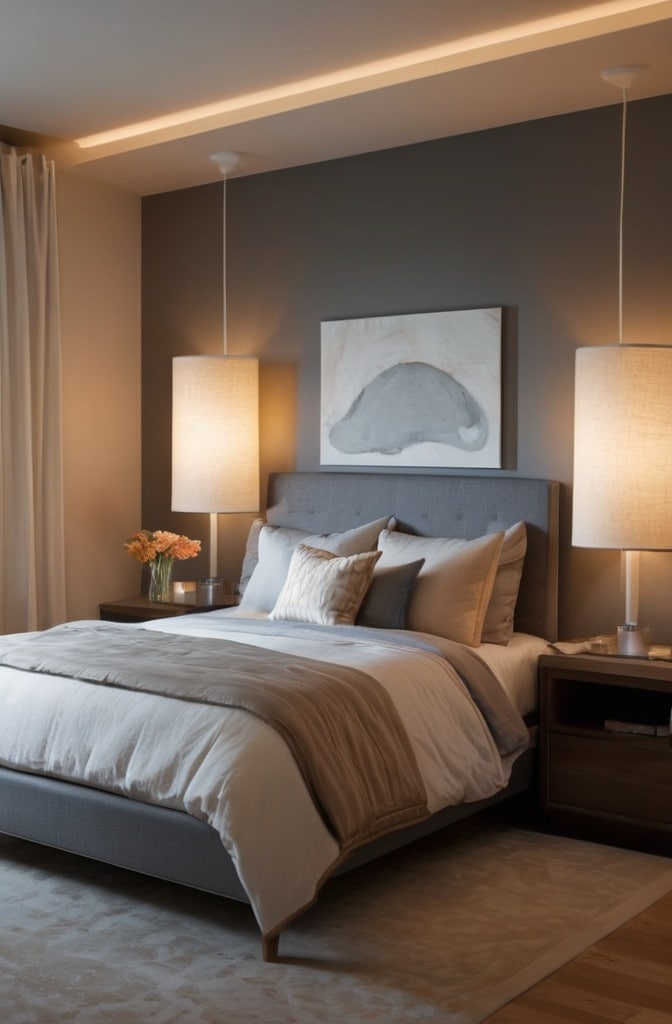
Your bed frame isnt just functional—it’s the architectural centerpiece of the entire room. “The bed frame is to the bedroom what the sofa is to the living room,” notes furniture designer Thomas Bina. “It establishes the design language for everything else.”
Trending bed frame styles that make a statement:
- Curved headboards that soften rectangular rooms
- Platform beds with integrated floating nightstands
- Canopy frames that create architectural interest without blocking light
- Upholstered frames in unexpected materials like bouclé or performance velvet
For small spaces, consider these space-maximizing options:
- Wall-mounted headboards with integrated lighting
- Beds with hydraulic storage that lift to reveal generous storage space
- Floating platform frames that create the illusion of more floor area
- Custom corner designs that utilize awkward room angles
DIY enthusiasts might consider creating a custom headboard—one of the most impactful bedroom projects with relatively modest skill requirements. Popular approaches include upholstered panels, salvaged wood installations, or even creative alternatives like vintage doors or decorative room screens.
5. Illumination Strategy: Layered Lighting Solutions

Effective bedroom lighting goes beyond a ceiling fixture and table lamp. Professional designers use a three-layer approach:
- Ambient lighting provides overall illumination (overhead fixtures, cove lighting)
- Task lighting serves specific functions (reading lamps, vanity lights)
- Accent lighting highlights architectural features or decor (picture lights, LED strips)
“Many homeowners undercalculate their lighting needs,” says lighting designer Lindsey Adelman. “The average bedroom should have at least four light sources at different heights to create proper balance and functionality.”
Statement fixtures worth considering:
- Sculptural pendant lights that double as art pieces
- Articulating wall sconces that free up nightstand space
- Illuminated headboards with integrated reading lights
- Floor lamps with architectural presence
For sustainable options, LED technology has advanced significantly. Today’s LED bulbs can mimic the warm glow of incandescents while using 75% less energy and lasting up to 25 times longer. Look for LEDs with a color temperature between 2700K-3000K for bedrooms, which provides a warm, relaxing glow compared to cooler blue-toned options.
6. Accent Walls: Beyond Basic Paint
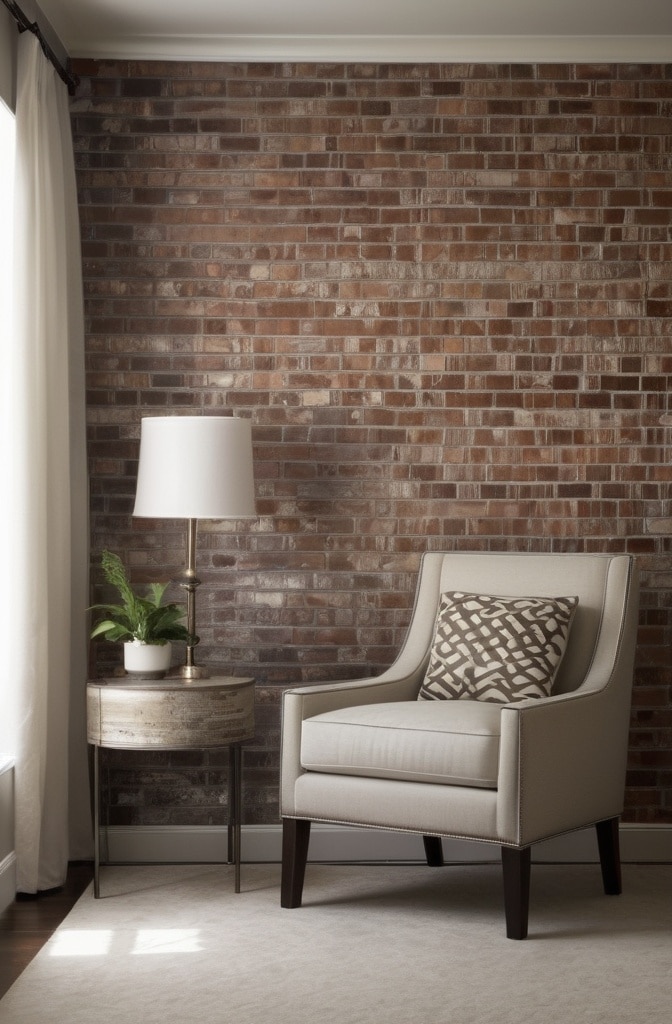
An accent wall creates a focal point that anchors the room—but today’s options go far beyond a simple coat of contrasting paint. “The fifth wall—your ceiling—is actually one of the most overlooked opportunities in bedroom design,” says interior architect Kelly Wearstler.
Modern accent wall approaches include:
- 3D textured panels in geometric or organic patterns
- Hand-applied plaster techniques like tadelakt or lime wash
- Fabric-wrapped walls for sound absorption and softness
- Custom wallpaper murals that create depth and perspective
For renters, removable options have come a long way:
- Peel-and-stick wallpaper with sophisticated designs
- Temporary wall treatments like fabric stretched on frames
- Decorative wall decals designed for easy removal
- Tension rod room dividers with fabric panels
The ceiling deserves consideration too—painting it a shade 50% lighter than your accent wall creates cohesion without heaviness, while decorative ceiling medallions or even wallpapered ceilings can transform the entire feel of a room with minimal effort.
7. Minimalist Bedroom Principles That Work

Minimalism isn’t about stark emptiness—it’s about intentional curation. “True minimalism isn’t the absence of things. It’s the perfect amount of the right things,” explains designer John Pawson, known for his minimalist spaces.
The 5:1 ratio rule provides practical guidance: for every five similar items you own, keep only one. This applies to everything from decorative objects to clothing to furniture pieces.
Common minimalist bedroom mistakes include:
- Removing texture along with objects, creating clinical rather than calm spaces
- Choosing uncomfortable furniture for its aesthetic simplicity
- Hiding essential items in impractical storage to maintain visual simplicity
- Focusing on aesthetics over functionality
Successful minimalist bedrooms incorporate:
- High-quality, multi-functional furniture pieces
- Rich textures in a limited color palette
- Meaningful objects rather than abundant decorations
- Negative space that allows the eye to rest
Functional minimalism emphasizes usefulness above all, while aesthetic minimalism prioritizes visual simplicity. The most successful minimalist bedrooms balance both approaches, creating spaces that work effortlessly while looking elegantly understated.
8. Incorporating Sustainable Wood Elements
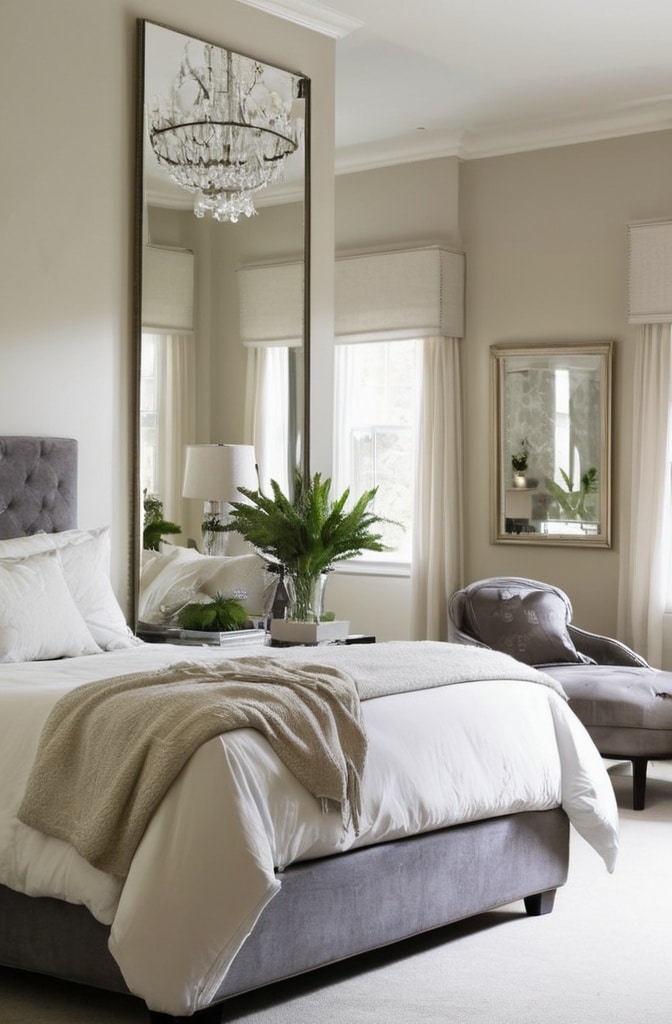
Wood brings irreplaceable warmth to bedroom spaces through its natural variation and connection to the outdoors. “Wood carries history and life into a space unlike any other material,” notes sustainable furniture maker George Nakashima’s daughter, Mira Nakashima.
For eco-conscious design, look beyond aesthetics to sourcing:
- FSC-certified woods ensure responsible forest management
- Reclaimed wood offers character with environmental benefits
- Rapidly renewable options like bamboo or eucalyptus provide sustainability
- Local hardwoods reduce transportation carbon footprint
When mixing wood tones, designers recommend using a unifying element:
- Match undertones (warm or cool) rather than exact colors
- Use one dominant wood tone with others as accents
- Connect disparate woods with metal or fabric elements
- Maintain consistent finish types (all matte or all glossy)
Unexpected wooden accents to consider:
- Wooden wall sconces or pendant light fixtures
- Carved wooden mirror frames or wall art
- Window valances or cornices in light-toned woods
- Wooden room divider screens or decorative panels
To maintain wooden elements, especially in humid bedroom environments, use natural beeswax polish rather than silicone-based products, which can seal in moisture and lead to degradation over time.
9. Mirror Magic: Strategic Placement for Space Enhancement
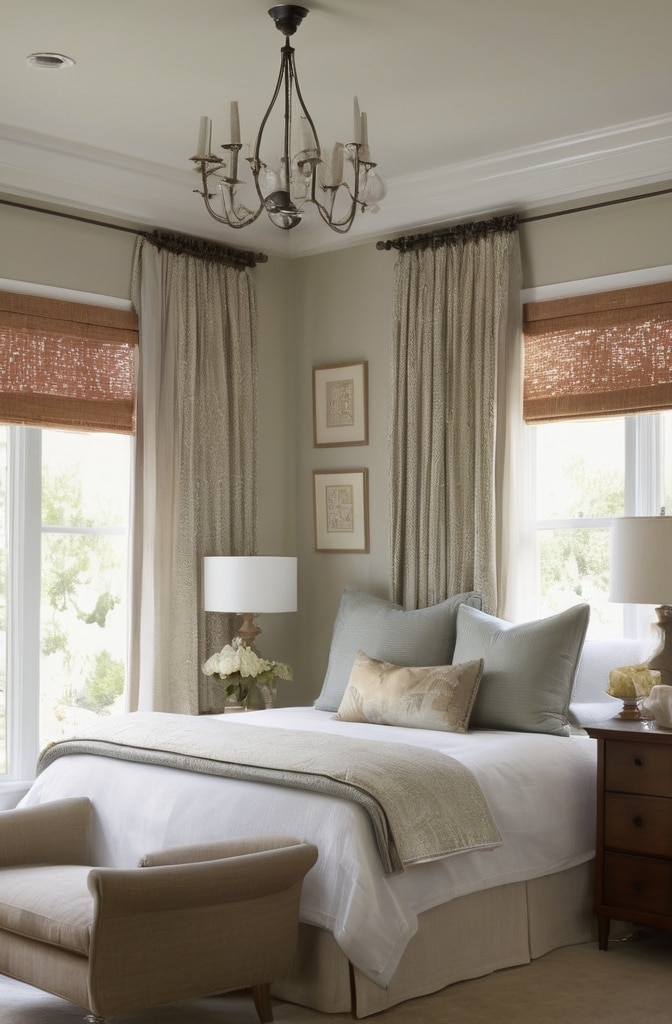
Mirrors do more than reflect your appearance—they manipulate light and perception to transform spaces. “A well-placed mirror isn’t just decorative; it’s architectural,” says interior designer Miles Redd.
Strategic mirror placement techniques:
- Position directly across from windows to double natural light
- Place adjacent to light sources rather than directly opposite to prevent glare
- Use full-length mirrors on windowless walls to create “virtual windows”
- Angle mirrors toward attractive features you want to highlight
For small bedrooms, designers recommend:
- Full wall mirror installations behind furniture to visually double the space
- Mirrored furniture with antiqued finishes that reflect without overwhelming
- Clusters of small decorative mirrors that bounce light while adding art-like interest
- Mirrored closet doors with minimal framing for maximum visual expansion
When selecting mirror frames, contrast is key. Heavy, ornate frames create depth and importance in minimalist spaces, while sleek, simple frames complement more decorated rooms without competing for attention.
10. Window Treatments: Balancing Privacy and Style

Window treatments serve multiple practical functions while defining your bedroom’s aesthetic. “Windows are the eyes of a room,” notes textile designer Sheila Bridges. “How you dress them reveals the room’s personality.”
Beyond standard curtains, consider:
- Layered solutions combining sheer privacy panels with blackout drapes
- Top-down/bottom-up shades that allow light while maintaining privacy
- Motorized systems programmable to adjust with the sun’s position
- Japanese-inspired sliding panels for clean, architectural lines
For energy efficiency, insulated cellular shades can reduce heat loss through windows by up to 40% according to the Department of Energy, paying for themselves through reduced heating and cooling costs within a few years.
Custom treatments worth the investment for unusual windows:
- Arched window toppers that highlight architectural features
- Corner window solutions that maximize light without awkward rod placement
- Skylight shades that adjust with remote controls
- French door panels that maintain function while adding style
11. Creating the Ultimate Reading Retreat
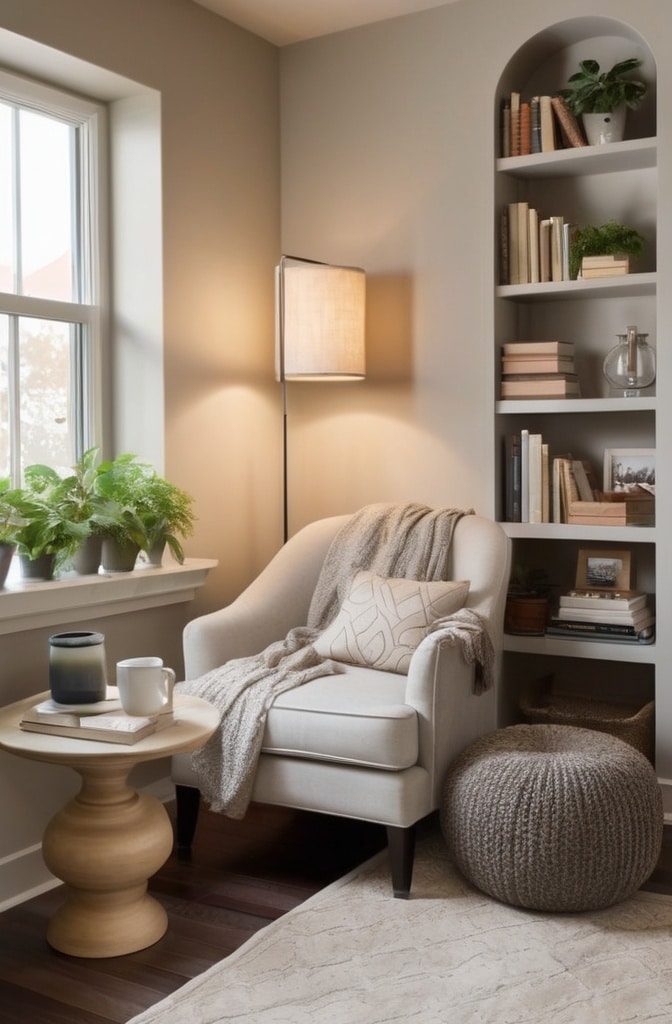
A dedicated reading nook transforms a bedroom from simply a place to sleep into a multi-functional sanctuary. According to a 2023 survey by the American Library Association, people who have designated reading spaces in their homes read an average of 50% more books annually.
Essential components of an effective reading corner:
- Seating with proper ergonomic support for extended reading
- Task lighting positioned to illuminate pages without glare (adjustable is ideal)
- Surface space for beverages and multiple books
- Acoustic considerations to absorb sound for better concentration
For small bedrooms, multi-functional approaches work best:
- Window seats with storage beneath for books and accessories
- Corner armchairs that can be pulled into other room configurations when needed
- Headboards with integrated bookshelves and reading lights
- Folding screens that create temporary reading zones when desired
“The key to a successful reading nook is that it should feel separate from the rest of the room—even if it’s just psychologically separate,” explains librarian and design consultant Pamela Sandlian Smith.
12. Wall Art Strategies for Personal Expression
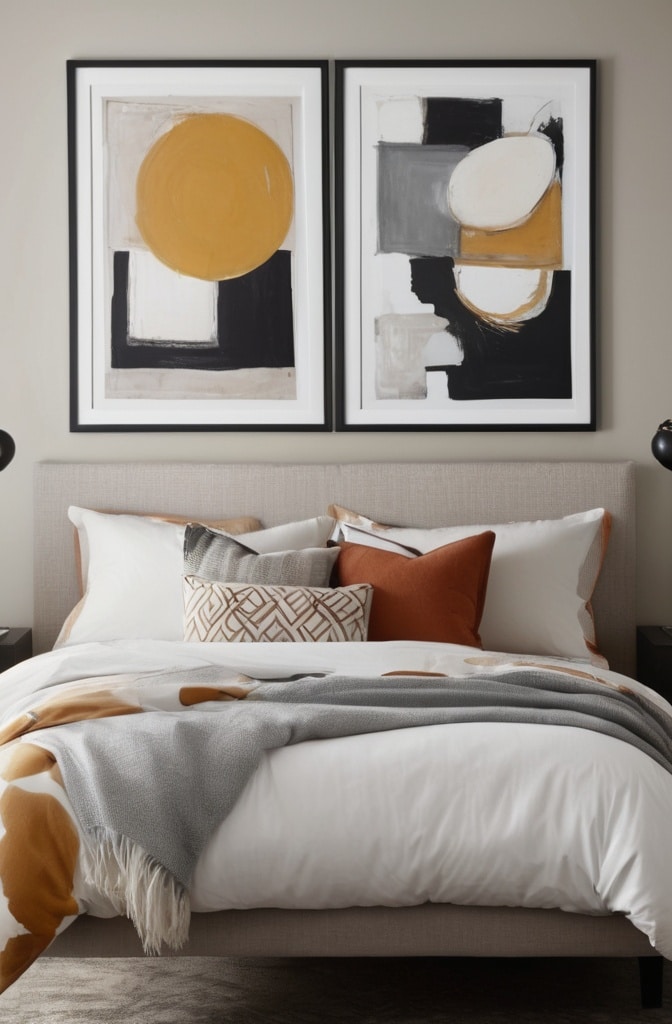
Wall art creates immediate personality and focal points within bedrooms. “Art in the bedroom should be personal above all else,” advises gallery owner Jen Bekman. “This isn’t the place for trying to impress visitors—it’s about what moves you.”
Creating cohesive gallery walls:
- Use consistent framing for diverse art pieces to create unity
- Maintain equal spacing between frames (2-3 inches is standard)
- Arrange pieces on the floor before hanging to test compositions
- Follow a visual theme (color palette, subject matter, or artistic style)
Beyond traditional frames, consider:
- Textile art like tapestries or quilts for texture and sound absorption
- Three-dimensional installations including ceramics or sculptural elements
- Projected art using digital projectors for ever-changing displays
- DIY artistic headboards that serve as both functional elements and art
For proper art hanging in bedrooms specifically:
- Position the center of the artwork at eye level when standing (approximately 57-60 inches from the floor)
- For art above beds, keep the bottom edge approximately 8-10 inches above the headboard
- Scale artwork to cover roughly two-thirds the width of the furniture below it
- Consider viewing angles from both standing and lying positions
13. Modern Industrial Elements: Raw Meets Refined
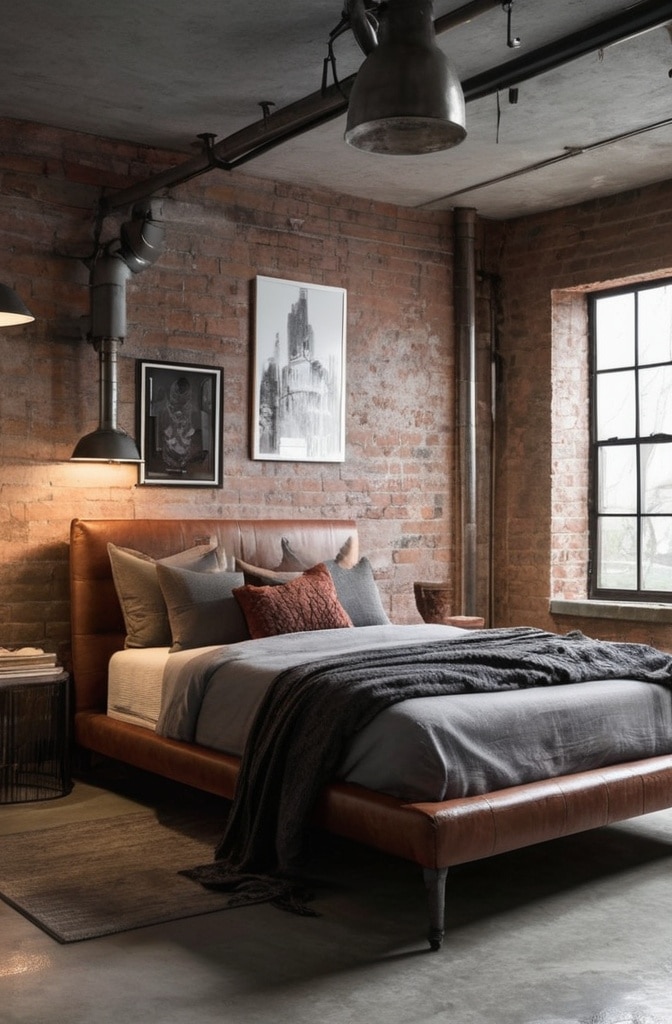
Industrial design brings character through authentic materials and architectural honesty, but pure industrial spaces can feel cold—especially in bedrooms. “The trick to successful industrial bedroom design is balancing raw elements with softness,” explains designer Joanna Gaines.
Industrial elements that add character without sacrificing comfort:
- Exposed brick walls (or convincing faux-brick wallpaper)
- Steel-framed room dividers with frosted or clear glass panels
- Repurposed factory fixtures converted to bedroom lighting
- Distressed wood paired with blackened steel accents
Warming industrial spaces:
- Layer soft textiles like chunky knit throws and high-pile rugs
- Incorporate plants to soften harsh lines and add life
- Mix in curved furniture pieces among angular industrial elements
- Use warm-toned metals like copper and brass rather than chrome
Budget-friendly industrial touches include:
- Pipe shelving systems that provide both storage and industrial aesthetic
- Edison bulb lighting fixtures with exposed filaments
- Open closet systems with metal piping and reclaimed wood
- Industrial-style hardware replacements for existing furniture
14. Strategic Storage: Functional Yet Beautiful
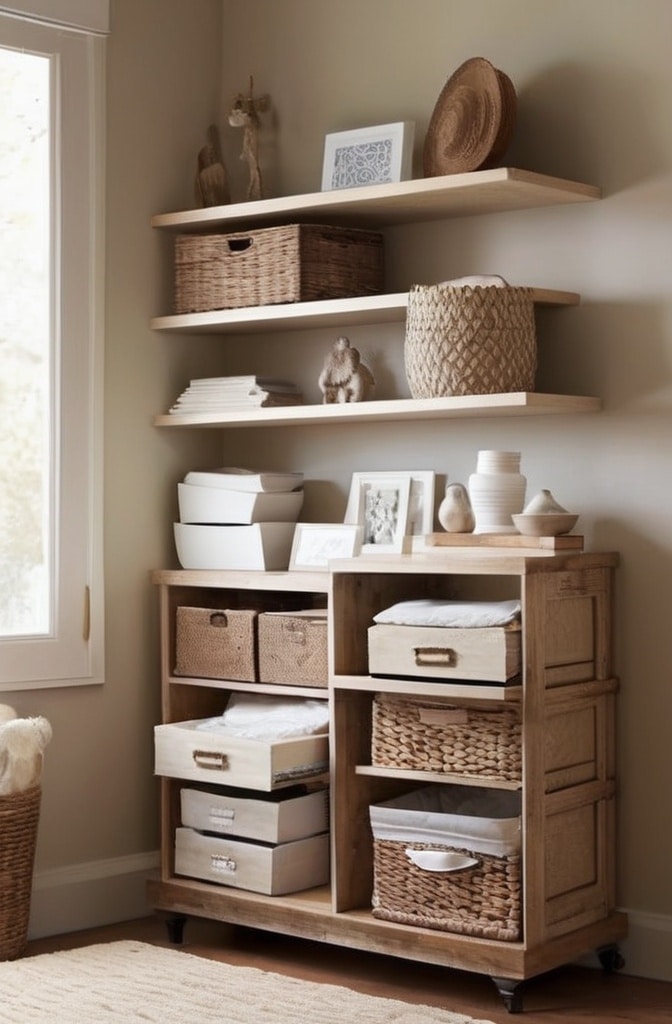
Effective bedroom storage maintains order while enhancing the room’s aesthetic. “Storage should be invisible when you want it to be and beautiful when it’s visible,” notes organization expert Marie Kondo.
Hidden storage solutions that preserve aesthetics:
- Hydraulic lift bed platforms with cavernous storage beneath
- Headboards with concealed compartments for infrequently used items
- Window seats and benches with hinged tops for seasonal storage
- Hollow ottomans that serve triple duty as seating, storage, and footrests
Vertical storage maximizes floor space:
- Floor-to-ceiling built-ins flanking windows or doors
- Floating shelves installed in unexpected spaces like above doors
- Pegboard systems customizable to changing storage needs
- Tension rod systems that create adjustable storage between walls
For visible storage, the key is consistency. Choose decorative boxes, baskets, or containers in complementary materials and styles. According to professional organizer Shira Gill, “Limiting your storage containers to 2-3 types creates visual calm even when the storage is visible.”
15. Small Space Solutions: Maximizing Limited Square Footage
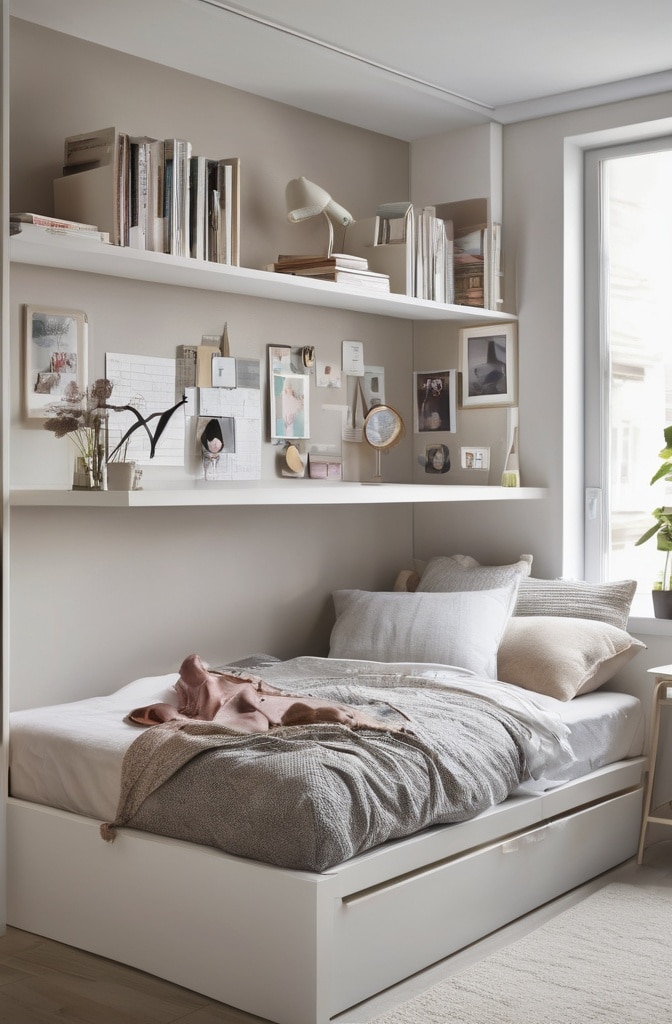
Small bedrooms require strategic design to feel spacious and functional. According to apartment therapist Maxwell Ryan, “The biggest mistake in small bedrooms is trying to fit too much in—edit ruthlessly and think vertically.”
Optical illusions that expand perceived space:
- Monochromatic color schemes that blur boundaries between surfaces
- Striped patterns that draw the eye upward to heighten ceiling perception
- Furniture with visible legs that create airflow beneath pieces
- Transparent furniture elements like acrylic chairs or glass tabletops
Multi-purpose furniture worth investing in:
- Murphy beds that convert to desks or seating during daytime
- Nightstands with desk extensions that pull out when needed
- Storage benches that provide seating and organization
- Loft beds that create usable space beneath for work or relaxation areas
Creating micro-zones in limited space:
- Define areas with area rugs or ceiling treatments rather than space-consuming dividers
- Use lighting to create distinct functional zones within one room
- Employ color-coding to visually separate spaces dedicated to different activities
- Create “rooms within rooms” using canopies or partial walls
16. Vintage Integration: Creating Timeless Character
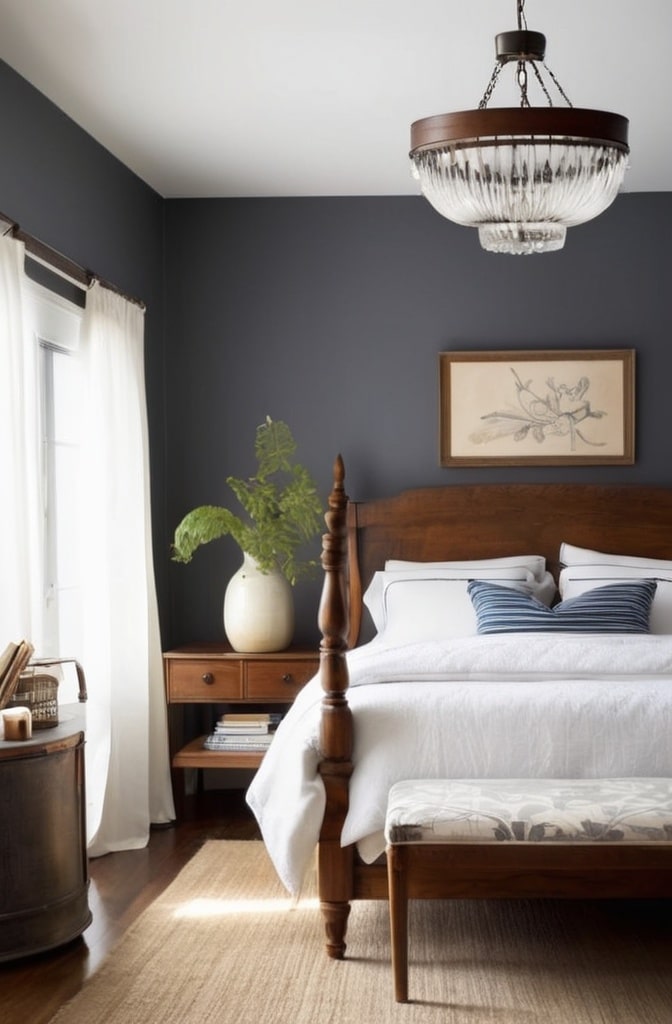
Vintage pieces add soul and history to bedroom spaces. “A room without something old in it is like a person without memories,” says renowned designer Albert Hadley.
Effectively mixing vintage and contemporary elements:
- Use vintage pieces as statement focal points among modern basics
- Balance ornate vintage items with clean-lined contemporary pieces
- Connect disparate styles through consistent color palette
- Maintain proportional balance between heavy vintage pieces and lighter modern elements
When sourcing vintage bedroom furniture:
- Check drawer functionality and structural integrity before purchasing
- Look for solid wood construction rather than veneers when possible
- Inspect for signs of pest damage or water damage
- Test original hardware for functionality or factor in replacement costs
Cohesion strategies for mixing period pieces:
- Unify diverse furniture through consistent hardware finishes
- Use textiles like bedding and window treatments to bridge style differences
- Repaint non-valuable vintage pieces in colors that complement your scheme
- Reupholster vintage seating in contemporary fabrics for fresh relevance
17. Biophilic Design: Bringing Nature Indoors

Biophilic design—incorporating natural elements into built environments—significantly impacts wellbeing. Research from the University of Exeter found that employees in spaces with natural elements showed a 15% increase in wellbeing and productivity compared to those in sterile environments.
Low-maintenance bedroom plants:
- Snake plants and ZZ plants thrive in low light with minimal watering
- Lavender provides pleasant aroma with calming properties
- Pothos and philodendrons purify air while requiring little care
- Air plants need no soil and minimal maintenance
For those with allergies or limited natural light:
- Preserved moss walls provide texture without maintenance
- Botanical prints and nature photography offer visual connection to outdoors
- Natural materials like stone, wood, and clay provide biophilic benefits
- Fractalized patterns that mimic natural forms reduce stress according to research
Beyond plants, consider:
- Water features like small tabletop fountains provide soothing sounds
- Natural ventilation strategies that bring in fresh air
- Views of nature through strategic window placement
- Nature-inspired textures and patterns in textiles and wall coverings
18. Personalizing Without Cluttering
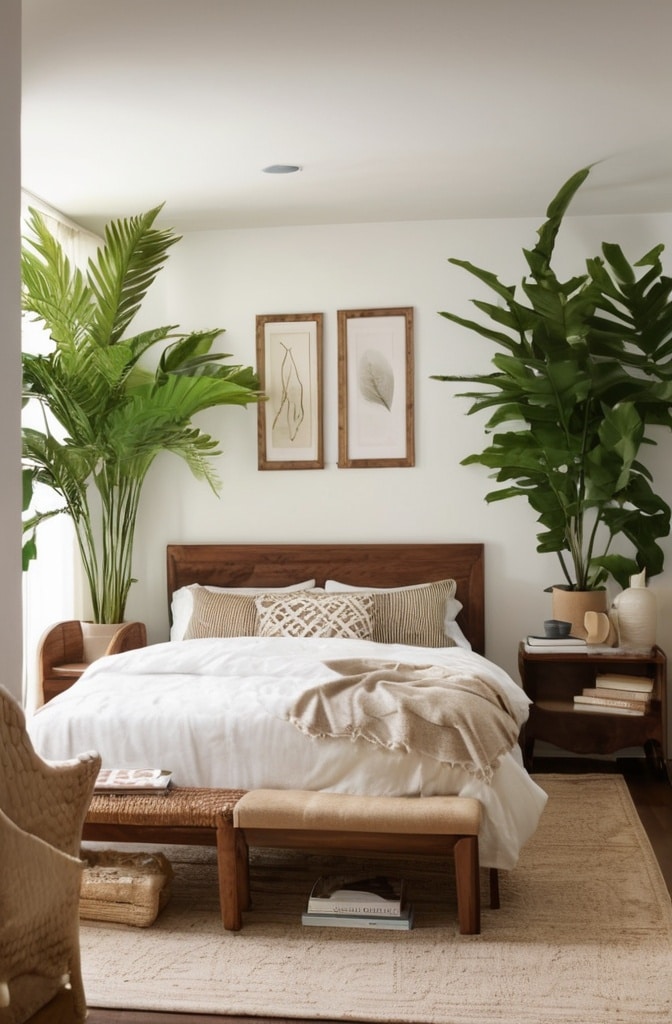
Personal touches transform a bedroom from generic to uniquely yours, but there’s a fine line between personalization and clutter. “Edit your possessions down to those that tell your story clearly,” advises designer Ilse Crawford.
The “meaningful object” approach:
- Display fewer items but ensure each carries significant personal meaning
- Group similar objects together rather than scattering throughout the room
- Rotate personal collections seasonally rather than displaying everything at once
- Create dedicated display areas like memory shelves or curio cabinets
Creating visual balance with personal items:
- Follow the 60-30-10 rule: 60% of the room as base color, 30% secondary color, 10% for personal accent colors
- Maintain negative space around displayed items to prevent visual crowding
- Use consistent frames or display methods for varied personal items
- Balance asymmetrical personal displays with symmetrical furniture arrangements
Rotation systems prevent stagnation:
- Create seasonal “capsule decor” collections that rotate quarterly
- Maintain a dedicated storage box for items awaiting rotation
- Photograph current arrangements before changing to track successful combinations
- Set calendar reminders for refreshing displays to prevent design inertia
19. Tech Integration: Smart Bedrooms for Modern Living

Technology can enhance bedroom functionality while remaining visually unobtrusive. “The best technology in bedrooms is the kind you don’t see until you need it,” notes smart home designer Michael Menn.
Hidden tech solutions:
- Televisions concealed in foot-of-bed cabinets that rise with remote control
- Charging stations integrated into nightstand drawers
- Speakers installed within walls or ceilings for ambient sound
- Projectors that display onto blank walls when needed, disappearing when not in use
Wellness technology worth considering:
- Smart mattresses that track sleep patterns and adjust firmness
- Programmable lighting that shifts color temperature to support circadian rhythms
- Air purification systems that monitor and improve air quality
- White noise machines with customizable soundscapes
Cable management solutions:
- Cord channels that adhere to walls for a clean look
- Furniture with integrated cord management systems
- Wireless charging pads built into nightstands
- Power strips mounted to the underside of furniture
Creating tech-free zones within bedrooms supports better sleep. According to sleep scientist Matthew Walker, “The bedroom should be a shrine to sleep,” with technology limited to tools that actively support rest rather than distract from it.
20. Zoning Strategies for Multi-functional Bedrooms

Today’s bedrooms often serve multiple purposes, especially in smaller homes. Interior designer Sarah Richardson suggests, “Think of a multi-functional bedroom as several rooms in one, each deserving its own distinct design consideration.”
Creating distinct areas without walls:
- Use area rugs to define separate functional zones
- Position furniture at angles to create natural divisions
- Install ceiling treatments that designate different areas
- Use decorative screens or open shelving as room dividers
Visual cues that differentiate zones:
- Color-coding through accessories or accent walls
- Lighting types unique to each functional area
- Ceiling treatments that define different zones
- Flooring transitions between functional areas
Balancing multiple functions requires prioritization. Sleep function should always dominate in terms of space allocation and positioning (typically the quietest area, farthest from the door). Secondary functions should be arranged by frequency of use, with most-used activities placed for greatest accessibility.
21. Seasonal Adaptation: Designs That Evolve
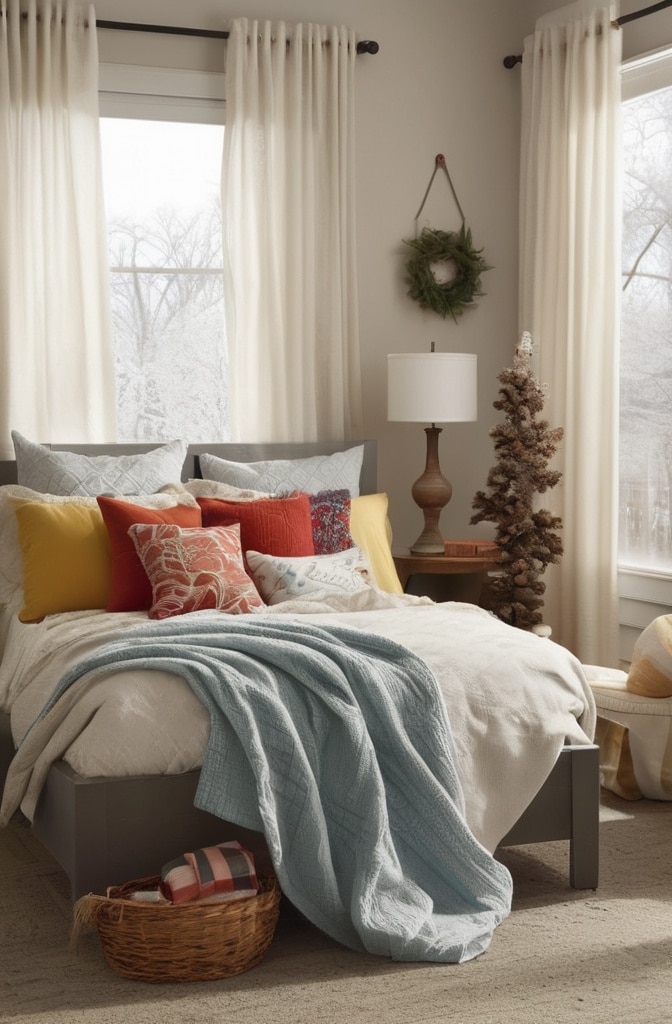
Seasonal bedroom adjustments enhance comfort while keeping spaces feeling fresh. “A bedroom should respond to the seasons just as our bodies do,” explains designer Bunny Williams.
Core pieces versus seasonal rotation items:
- Invest in neutral foundational furniture and architectural elements
- Change bedding weight and material seasonally (linen for summer, flannel for winter)
- Rotate accent pillows, throws, and smaller decorative items quarterly
- Adjust window treatments between seasons for light and temperature control
Quick-change elements for seasonal refreshes:
- Duvet covers and pillow shams in seasonal colors or patterns
- Area rugs that can be switched between cooler options (like sisal) and warmer ones (like wool)
- Artwork that reflects seasonal themes or colors
- Scented elements appropriate to the season (lavender for spring, cinnamon for fall)
Storage solutions for off-season items:
- Under-bed containers with wheels for easy access
- Vacuum-sealed bags for bulky winter bedding during summer months
- Dedicated closet space with cedar elements to protect stored textiles
- Labeled bins in attic or basement storage organized by season
22. Wellness-Focused Design Elements
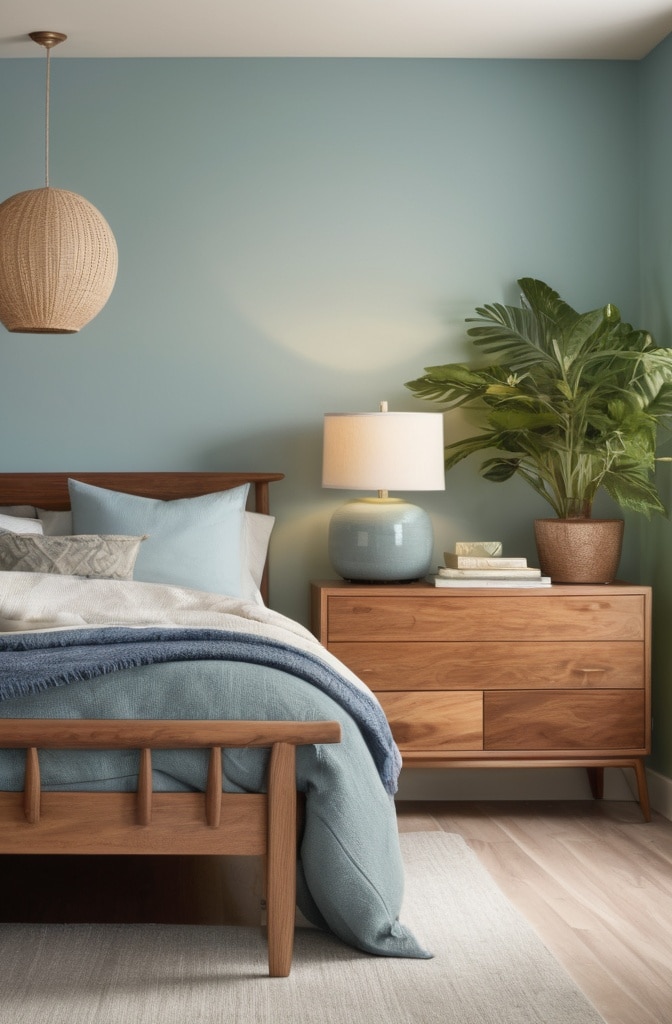
The bedroom significantly impacts physical and mental wellbeing through various environmental factors. “A bedroom should be designed with health as the primary consideration, aesthetics second,” advises Dr. Michael Breus, clinical psychologist and sleep specialist.
Air quality considerations:
- Indoor plants that naturally filter air (NASA studies show spider plants and peace lilies remove common toxins)
- Air purifiers with HEPA filtration for removing allergens and particulates
- Low-VOC paints and finishes to reduce chemical off-gassing
- Natural bedding materials that reduce potential allergens
Sound management for better sleep:
- Acoustic panels disguised as art pieces
- Heavy curtains that absorb sound reflections
- Soft flooring materials or rugs to reduce impact noise
- White noise machines or sound masking systems for consistent sound environments
Ergonomic considerations:
- Mattresses and pillows selected for individual body types and sleep positions
- Seating with proper lumbar support for reading or other activities
- Proper heights for nightstands relative to mattress height (typically within 2-3 inches)
- Task lighting positioned to prevent neck strain during reading
Research-backed stress reduction elements:
- Nature views or nature artwork (studies show even images of nature reduce stress hormones)
- Blue-green color palettes proven to lower heart rate and blood pressure
- Symmetrical arrangements that create visual balance and reduce cognitive load
- Minimized visual stimulation in the immediate sleep area
Conclusion
Your bedroom should be more than just aesthetically pleasing—it should support your wellbeing, reflect your personality, and enhance your daily life. By implementing even a few of these 22 ideas, you can transform your bedroom into a truly elevated personal space that serves both functional and emotional needs.
Remember that the most successful bedroom designs evolve over time, incorporating new elements as your needs and preferences change. The key principles remain constant: prioritize comfort, express personal style, maintain functionality, and create a space that supports rest and rejuvenation.
Which of these bedroom interior ideas resonates most with you? Whether you’re planning a complete redesign or looking for small updates with big impact, there’s no better time than now to create the bedroom retreat you deserve.
